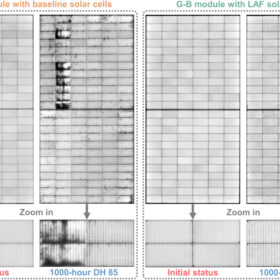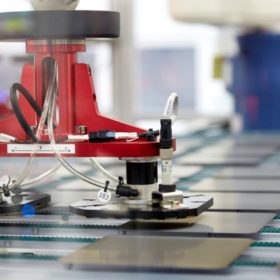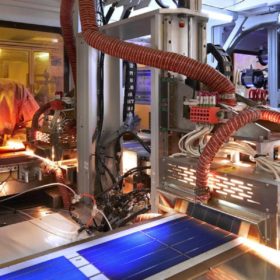EVA-induced degradation has significant impact on power losses in TOPCon solar modules
New research from UNSW shows that EVA-encapsulated TOPCon solar modules under damp-heat testing can suffer significant power losses and fill factor drops. The study describes metallization degradation mechanisms driven by EVA-generated contaminants and demonstrates the effectiveness of metallization adjustments in reducing EVA-induced degradation rates
Current UV tests overestimate TOPCon solar module degradation
Fraunhofer Institute for Solar Energy Systems ISE (Fraunhofer ISE) has found that current UV testing methods overestimate degradation in tunnel oxide passivated contact (TOPCon) solar modules, as dark storage after UV exposure causes temporary efficiency losses that largely reverse under sunlight.
TOPCon solar cell based on aluminum contacts achieves slightly lower efficiency than silver-based counterpart
Researchers in Australia have have fabricated an aluminum contact-based TOPCon solar cell based that achieved a power conversion efficiency of 22.92%. The device was built with an aluminum contact manufacturing process that reportedly does not compromise the surface passivation quality of underlying silicon oxide layers.
New research shows degradation mechanisms in rear side of TOPCon solar cells
Researchers from UNSW and Longi have found that the silicon nitride layers used in TOPCon cell rear-side are particularly prone to chemical degradation from sodium contaminants. This can lead to significant open-circuit voltage losses and reduce cell efficiency.
First Solar sues JinkoSolar for alleged TOPCon patent infringement
First Solar has sued JinkoSolar in a US federal court in Delaware, claiming that the Chinese manufacturer infringed upon US Patent No. 9,130,074, which is related to tunnel oxide passivated contact (TOPCon) solar technology.
TOPCon IP battle intensifies with Qcells launching infringement notices
Qcells has launched an intellectual property (IP) dispute over alleged unauthorized use of its patented laser-enhanced contact opening (LECO) tech in tunnel oxide passivated contact (TOPCon) solar cells. The case underscores rising tensions in the PV industry over TOPCon patents.
Trina Solar claims 25.9% efficiency for large-area industrial TOPCon solar cells
The Chinese manufacturer said the result was confirmed by Germany’s Institute for Solar Energy Research in Hamelin.
Carbon provides clarity on patent case with JA Solar
French PV manufacturer Carbon says it is leading a consortium that has filed a patent opposition against JA Solar’s tunnel oxide passivated contact (TOPCon) patent at the European Patent Office (EPO) in May 2023. In early October, the EPO upheld the patent as valid, but Carbon says this ruling is only preliminary.
Runergy urges US authorities to revoke two of Trina Solar’s TOPCon patents
Runergy is pushing the US Patent and Trademark Office (USPTO) to cancel Trina Solar’s tunnel oxide passivated contact (TOPCon) patents, US9,722,104 and US10,230,009.
New research shows vulnerability of TOPCon solar cells to contact corrosion
Researchers at the University of New South Wales claim to have identified new TOPCon contact degradation mechanisms that are significantly influenced by the combination of ions and aluminum-silver paste compositions. The primary degradation mechanism was a significant increase in series resistance.










